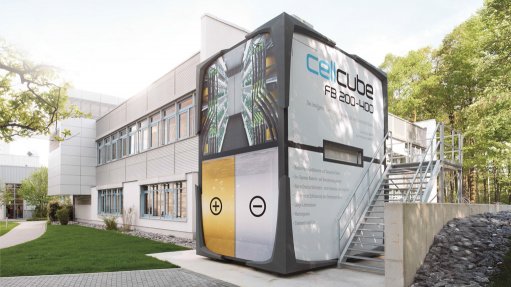
Photo by: American Vanadium
TORONTO (miningweekly.com) – North America’s first vanadium redox flow energy-storage system provider American Vanadium on Friday announced that it had signed up its first customer, subject to financing.
American Vanadium said it believed the order from Newfound Energies would enable the company to switch its primary source of energy from diesel to renewables, resulting in significantly reduced diesel consumption and related costs, proving the powerful economic model for such applications.
TSX-V-listed American Vanadium, which was also developing what had been billed as the only economically viable vanadium deposit in North America, the Gibellini vanadium project, in Nevada, reported that Newfound Energies had signed a purchase order for two 30 KW to 130 KWh CellCube energy-storage systems for integration into a remote microgrid fuel and logistics centre.
This signified the first purchase order for American Vanadium since striking a master agreement, in May last year, that allowed it to market and sell German energy solutions provider Gildemeister’s CellCube vanadium redox flow batteries in North America.
"This marks an important milestone on our path to commercialisation for the CellCube product line here in North America, which is recognised as the fastest-growing segment of the global market for energy storage. We are uniquely positioned with the CellCube system and, based on our sales pipeline and the ongoing developments in our markets, we are confident this is the start of a sales programme which will grow at an impressive pace," American Vanadium president and CEO Bill Radvak said, noting that with more than 100 systems installed globally and with an operating record of close to five years, CellCube was both the first-mover and the market leader.
A recent independent report from Navigant Research, pointed to microgrids emerging as a global phenomenon owing to their compelling features, including the ability to isolate themselves from the utility distribution system during power outages and to employ the use of conventional fuels as well as integrate diverse renewable-energy sources.
The report also noted that advanced energy storage was expected to represent the single-largest investment category among microgrid-enabling technologies by 2023.
"We chose the CellCube technology because of its high-capacity and long-duration capabilities. Our remote locations need to use 100% depth of discharge of the systems every day to reach our efficiency targets. We simply cannot hit this mark and maintain battery performance over the life of our sites with other technologies.
“We are looking forward to our transition away from expensive diesel and hope for this to be the first of many of our sites to benefit from this technology,” Newfound Energies president Gerry Skinner said.
The maiden commercial sale followed short on the heels of American Vanadium’s recent deployment of a CellCube at the US Department of Energy's National Renewable Energy Laboratory, in Colorado, and preceded the upcoming flagship roof-top installation with the Metropolitan Transportation Authority, in downtown Manhattan, New York.